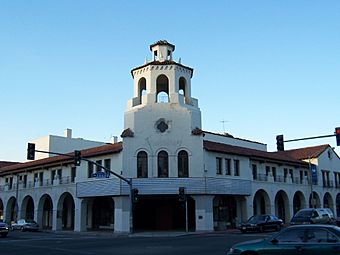Fox Performing Arts Center facts for kids
|
Fox Theater
|
|
 |
|
| Address | 3801 Mission Inn Avenue Riverside, California United States |
|---|---|
| Owner | City of Riverside |
| Operator | Live Nation |
| Type | Movie palace |
| Capacity | 1,646 |
| Screens | 1 |
| Current use | Live event venue |
| Construction | |
| Opened | 1929 |
| Reopened | 2010 |
| Fox Theater | |
|---|---|
| Lua error in Module:Location_map at line 420: attempt to index field 'wikibase' (a nil value). | |
| Architect | Balch and Stanbury |
| Architectural style(s) | Spanish Colonial Revival |
| Reference no. | 39 |
The Riverside Fox Theater, also known as the Fox Performing Arts Center, is a beautiful building in downtown Riverside, California. It was built in 1929 in a style called Spanish Colonial Revival. This theater is a very important part of Riverside's plan to improve its arts and culture. It went through a big makeover and opened again in January 2010.
The Fox Theater is famous for showing the movie Gone With the Wind for the very first time in 1939. This film is still one of the most successful movies ever, when you consider how much money it made over time.
Contents
History of the Fox Theater
The Riverside Fox Theater was designed by architects Clifford Balch and Floyd E. Stanberry. They designed many "West Coast Theaters" and later, Fox Theaters. The Riverside Fox Theater was part of a group of theaters built by Abe and Mike Gore, Adolph Ramish, and Sol Lesser. These partners built many local theaters in Southern California during the 1920s.
In 1928, William Fox of Fox Studios bought a large part of this theater group. It then became known as Fox West Coast Theaters. This partnership helped the film industry by making it easier to show movies after they were made. However, this partnership did not last long because of business rules and William Fox's money problems. The company faced financial difficulties in the early 1930s. In 1932, the theater became part of the National Theaters chain, which was a very big and successful theater chain in the United States.
During the 1930s and 1940s, Hollywood movie makers used the Fox Theater to show new movies before they were completely finished. Riverside was a good place for these previews because its population was similar to many small towns across America. By showing movies here, film companies could see how a typical audience would react. This helped them make final changes to their films.
The Fox Theater During World War II
During World War II, the Fox Theater helped soldiers. When nearby military bases were full, the theater let soldiers sleep on the soft carpets in its lobby and main room.
In 1942, the Fox Theater changed its stage area into a smaller, second theater called the "Lido." This new space could hold 536 people and showed movies that had already been released. The theater also added new sound-absorbing materials to its main room.
After World War II, the area around the Fox Theater changed, and fewer people came to the theater. In 1978, a company called Walnut Properties bought the theater. The main theater started showing Spanish language films.
Today, the Fox Theater is recognized as an important place in movie history. It is located at the corner of Mission Inn Avenue and Market Street.
Renovation and Reopening
In 2006, the City of Riverside bought the Fox Theater. They wanted to create a performing arts center for the community. The renovation of the Fox Theater was part of a huge city project called "Riverside Renaissance." This project aimed to complete many improvements in a short time.
The $35 million renovation of the Fox Theater started on May 3, 2007. It was finished in late 2009, and the theater officially reopened in January 2010.
Who Operates the Theater Now?
After it reopened, FX Arts Management ran the Fox Performing Arts Center for almost four years. They worked with the Nederlander Corporation for two years. Later, they worked with Tom McCoy and Cathy Rigby for Broadway shows. Since December 1, 2013, a company called Live Nation has been in charge of running the theater.
See also
- House Of Blues
- De Anza Theater


